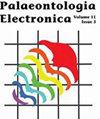基于加权适宜性分析的美国犹他州早白垩世雪松山组化石位置预测模型
IF 1.5
4区 地球科学
Q2 PALEONTOLOGY
引用次数: 0
摘要
本文章由计算机程序翻译,如有差异,请以英文原文为准。
A fossil locality predictive model using weighted suitability analysis for the Early Cretaceous Cedar Mountain Formation, Utah, USA
Hard work and chance are nearly always among the deciding factors in finding new, important, and productive paleontological localities. Fossil locality predictive models have the potential to maximize field time and increase chances to find important localities. This study uses remotely sensed data to design and test a fossil locality predictive model for the Early Cretaceous Cedar Mountain Formation. Landsat 8 OLI/TIRS data from known localities were summarized, reclassified, and used in a weighted suitability analysis to categorize fossil locality potential of the study area. Field work was conducted to test model functionality. Field observations were used to refine the weighted suitability analysis. Landsat 8 OLI/TIRS data alone offers a less accurate prescription of fossil locality potential. Additional physical and environmental factors play a role in determining the chance of finding fossils. Slope degree and aspect data from known localities were summarized and analyzed to further refine the model. Forty percent of existing fossil localities within the final model boundaries were located on areas having the highest fossil locality potential as identified by the model. The usefulness of fossil locality predictive models is dependent upon the quality of input data and meth-ods used to determine fossil locality potential. To fully determine the quality of a fossil locality predictive model, field testing is ideal.
求助全文
通过发布文献求助,成功后即可免费获取论文全文。
去求助
来源期刊

Palaeontologia Electronica
PALEONTOLOGY-
CiteScore
3.30
自引率
0.00%
发文量
20
审稿时长
>12 weeks
期刊介绍:
Founded in 1997, Palaeontologia Electronica (PE) is the longest running open-access, peer-reviewed electronic journal and covers all aspects of palaeontology. PE uses an external double-blind peer review system for all manuscripts. Copyright of scientific papers is held by one of the three sponsoring professional societies at the author''s choice. Reviews, commentaries, and other material is placed in the public domain. PE papers comply with regulations for taxonomic nomenclature established in the International Code of Zoological Nomenclature and the International Code of Nomenclature for Algae, Fungi, and Plants.
 求助内容:
求助内容: 应助结果提醒方式:
应助结果提醒方式:


